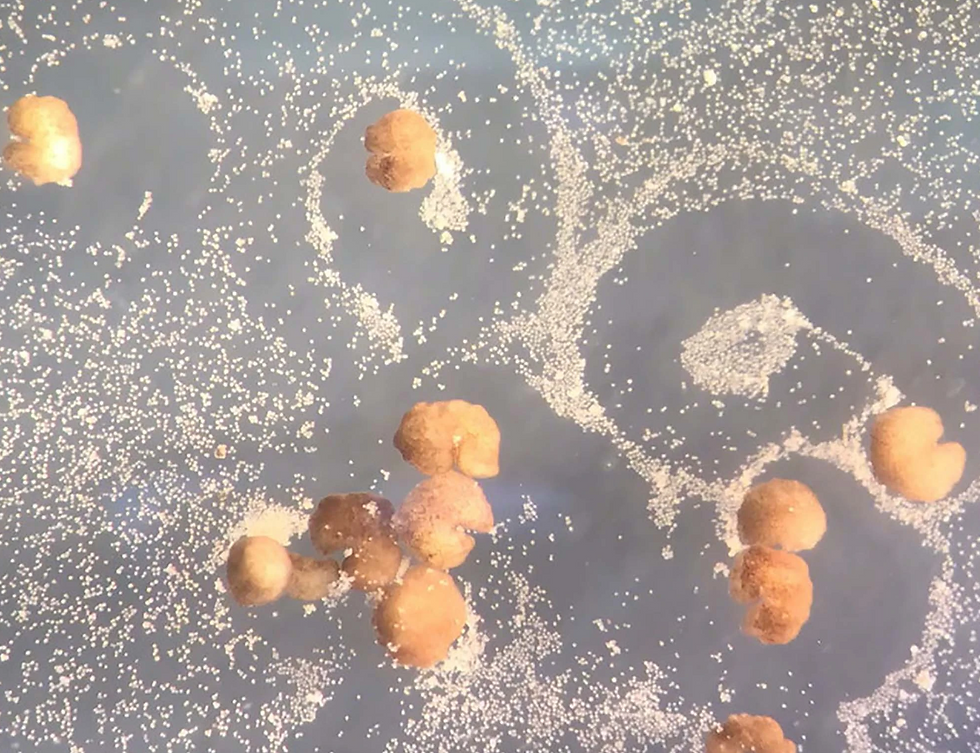Living Robots: Answers They Provide and New Questions They Pose
- Gawon Yoo

- May 14, 2023
- 4 min read
Updated: Feb 19
Xenobots—also known as the “living robots”—resemble soft, diminutive popcorn pieces, contrary to the commonly depicted imagery of metallic devices with an overwhelming input of wires. Made of dissociated pluripotent stem cells of Xenopus laevis (frog species) embryos, Xenobots display an array of interesting behaviors and capacities, one of which includes locomotion.
Researchers at Tufts Allen Discovery Center have previously worked towards cracking the morphogenetic code, defined as “the mechanisms and information structures by which networks of cells represent and dynamically regulate the target morphology of the system” (Allen Discovery Center). By collaborating with the Department of Computer Science at the University of Vermont, they developed a programmable bot that carries the potential to take the research in a new direction.
Dr. Michael Levin, the director of the Allen Discovery Center and codeveloper of Xenobots, put into perspective the idea that prompted the discovery: “One of the things we work on is the question of cellular plasticity—this idea that cells get together to build certain things, and normally, they build normal embryos. But the question is, what else can they build?” To further explore this question, the team ran a virtual simulation where artificial intelligence created random structural designs and filtered them based on their performances. In other words, the living robot’s evolutionary selection occurred in-silico (in computer modeling), where competent configurations of Xenobots were chosen out of the initial mix. Researchers then took the ultimately selected design and realized it in-vivo with embryonic cells using microsurgical techniques (Kreigman et al., 2020).

Recently, researchers have created self-replicating Xenobots that carry the ability to move around and collect loose cells in the medium. Each pile of cells assembles itself into a new generation of Xenobots, and the process then repeats to give rise to a new set of robots. Behind the scenes, the team utilized computer simulation to determine the optimal shape for Xenobots to reproduce. The results found the c-shaped configuration most compatible, and thus the Pacman-shaped, self-replicating version of the living robot came about.
While the research has given scientists more insight into the capabilities of the re-engineered embryo cells, Dr. Levin pointed out the unpredictability of future discoveries which adds to the explorative nature of the research. “A lot of [the research process] is unexpected in the sense that the community currently doesn’t have any way of predicting what else cells are capable of besides their normal outcome…And we get surprises every day…where they are doing new things that we didn’t expect.” Currently, the team is conducting several experiments to better comprehend the differences between normal frog embryos’ and Xenobots’ gene expression, memory retention, preferences, behavioral repertoires, and reaction to stimuli, which may indicate the level of cognitive performance.

As products of interdisciplinary work in the field of biology, computer science, and behavior or cognitive science, Xenobots suggest varying implications. Dr. Levin expressed his hope to see an impact in three broad areas. Firstly, the most direct application includes manipulating these living machines to perform practical actions. He provided a few examples: “we could imagine biobots that clean up the environment and do sensing exploration. Maybe in biotechnology, they sculpt bioengineered organs.”
Next, the second category has less to do with the direct usage of Xenobots, but rather about understanding cell behavior in the context of morphogenesis, a process through which tissues and organs acquire their shape. “Once we solve this question of how a collection of cells knows what to build, we will have a new regenerative medicine,” he added.
The final type of impact addresses the larger ethical and philosophical questions that inevitably arise along with the idea of living machines. “When we are surrounded by creatures that don’t have any of those [familiar] features, they’re completely alien…And [they] don’t come from the same evolutionary stream as we do.” He discussed that the discovery of Xenobots has challenged us to define our relationship with these robots, as well as redefine terms like “robots,” “living organisms,” and “machines,” which have been proven to be outdated.
From computer simulation to living robots completely composed of cells, collaboration among scientists from different specialties was key to the novel discovery. As a computer scientist working in biological media, Dr. Levin shared his hope for “an improved and continued integration between a few different sciences that up until now have been completely separate.” He especially highlighted the interdisciplinary application: “[What’s] more important than the specific technologies is the…idea that the tools, for example, from behavioral science can be applied outside the brain.”
Lastly, Dr. Levin acknowledged the remarkable contribution that undergraduate students have made annually. While he encouraged anyone interested in the research to reach out, he also spotlighted the McLaughlin Lab and the McVey Lab as other great opportunities for undergraduate students to explore.
References & Work Consulted:
Brown, J. (2022, November 14). Team Builds First Living Robots That Can Reproduce. Wyss Institute. Retrieved January 13, 2023, from https://wyss.harvard.edu/news/team-builds-first-living-robots-that-can-reproduce/
Kriegman, S., Blackiston, D., Levin, M., & Bongard, J. (2020). A scalable pipeline for designing reconfigurable organisms. Proceedings of the National Academy of Sciences, 117(4), 1853–1859. https://doi.org/10.1073/pnas.1910837117
The Paul G. Allen Frontiers Group. (n.d.). Allen Discovery Center at Tufts University. Allen Institute. Retrieved January 13, 2023, from https://alleninstitute.org/what-we-do/frontiers-group/discovery-centers/allen-discovery-center-tufts-university/

_edited_edited.png)



Comments